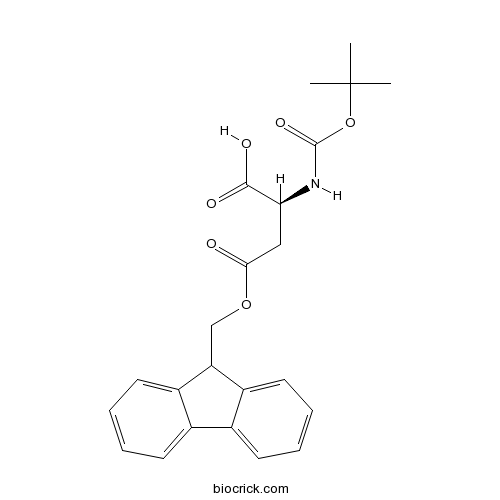Boc-Asp(Ofm)-OHCAS# 117014-32-1 |

Quality Control & MSDS
3D structure
Package In Stock
Number of papers citing our products

| Cas No. | 117014-32-1 | SDF | Download SDF |
| PubChem ID | 164019 | Appearance | Powder |
| Formula | C23H25NO6 | M.Wt | 411.5 |
| Type of Compound | N/A | Storage | Desiccate at -20°C |
| Solubility | Soluble in Chloroform,Dichloromethane,Ethyl Acetate,DMSO,Acetone,etc. | ||
| Chemical Name | (2S)-4-(9H-fluoren-9-ylmethoxy)-2-[(2-methylpropan-2-yl)oxycarbonylamino]-4-oxobutanoic acid | ||
| SMILES | CC(C)(C)OC(=O)NC(CC(=O)OCC1C2=CC=CC=C2C3=CC=CC=C13)C(=O)O | ||
| Standard InChIKey | NHLRMCFWGFPSLT-IBGZPJMESA-N | ||
| Standard InChI | InChI=1S/C23H25NO6/c1-23(2,3)30-22(28)24-19(21(26)27)12-20(25)29-13-18-16-10-6-4-8-14(16)15-9-5-7-11-17(15)18/h4-11,18-19H,12-13H2,1-3H3,(H,24,28)(H,26,27)/t19-/m0/s1 | ||
| General tips | For obtaining a higher solubility , please warm the tube at 37 ℃ and shake it in the ultrasonic bath for a while.Stock solution can be stored below -20℃ for several months. We recommend that you prepare and use the solution on the same day. However, if the test schedule requires, the stock solutions can be prepared in advance, and the stock solution must be sealed and stored below -20℃. In general, the stock solution can be kept for several months. Before use, we recommend that you leave the vial at room temperature for at least an hour before opening it. |
||
| About Packaging | 1. The packaging of the product may be reversed during transportation, cause the high purity compounds to adhere to the neck or cap of the vial.Take the vail out of its packaging and shake gently until the compounds fall to the bottom of the vial. 2. For liquid products, please centrifuge at 500xg to gather the liquid to the bottom of the vial. 3. Try to avoid loss or contamination during the experiment. |
||
| Shipping Condition | Packaging according to customer requirements(5mg, 10mg, 20mg and more). Ship via FedEx, DHL, UPS, EMS or other couriers with RT, or blue ice upon request. | ||

Boc-Asp(Ofm)-OH Dilution Calculator

Boc-Asp(Ofm)-OH Molarity Calculator
| 1 mg | 5 mg | 10 mg | 20 mg | 25 mg | |
| 1 mM | 2.4301 mL | 12.1507 mL | 24.3013 mL | 48.6027 mL | 60.7533 mL |
| 5 mM | 0.486 mL | 2.4301 mL | 4.8603 mL | 9.7205 mL | 12.1507 mL |
| 10 mM | 0.243 mL | 1.2151 mL | 2.4301 mL | 4.8603 mL | 6.0753 mL |
| 50 mM | 0.0486 mL | 0.243 mL | 0.486 mL | 0.9721 mL | 1.2151 mL |
| 100 mM | 0.0243 mL | 0.1215 mL | 0.243 mL | 0.486 mL | 0.6075 mL |
| * Note: If you are in the process of experiment, it's necessary to make the dilution ratios of the samples. The dilution data above is only for reference. Normally, it's can get a better solubility within lower of Concentrations. | |||||

Calcutta University

University of Minnesota

University of Maryland School of Medicine

University of Illinois at Chicago

The Ohio State University

University of Zurich

Harvard University

Colorado State University

Auburn University

Yale University

Worcester Polytechnic Institute

Washington State University

Stanford University

University of Leipzig

Universidade da Beira Interior

The Institute of Cancer Research

Heidelberg University

University of Amsterdam

University of Auckland

TsingHua University

The University of Michigan

Miami University

DRURY University

Jilin University

Fudan University

Wuhan University

Sun Yat-sen University

Universite de Paris

Deemed University

Auckland University

The University of Tokyo

Korea University
Boc-Asp(Ofm)-OH
- Bis(2-ethylhexyl) phthalate
Catalog No.:BCN6054
CAS No.:117-81-7
- 2-Anthraquinonecarboxylic acid
Catalog No.:BCN3451
CAS No.:117-78-2
- 2-Amino-3-hydroxyanthraquinone
Catalog No.:BCC8527
CAS No.:117-77-1
- Quercetin
Catalog No.:BCN6049
CAS No.:117-39-5
- Dantron
Catalog No.:BCN6048
CAS No.:117-10-2
- Rubiadin
Catalog No.:BCN6047
CAS No.:117-02-2
- Sculponeatic acid
Catalog No.:BCN6046
CAS No.:1169806-02-3
- Sculponeatin O
Catalog No.:BCN6045
CAS No.:1169806-00-1
- Sculponeatin N
Catalog No.:BCN6044
CAS No.:1169805-98-4
- INDY
Catalog No.:BCC6349
CAS No.:1169755-45-6
- XL413 hydrochloride
Catalog No.:BCC4039
CAS No.:1169562-71-3
- XL413
Catalog No.:BCC4241
CAS No.:1169558-38-6
- Anwuweizonic acid
Catalog No.:BCN3633
CAS No.:117020-59-4
- Licopyranocoumarin
Catalog No.:BCN7900
CAS No.:117038-80-9
- 3'-Methoxypuerarin
Catalog No.:BCN2900
CAS No.:117047-07-1
- Wulignan A1
Catalog No.:BCN5808
CAS No.:117047-76-4
- Combretastatin A4
Catalog No.:BCC7089
CAS No.:117048-59-6
- 3'-Hydroxypuerarin
Catalog No.:BCN2816
CAS No.:117060-54-5
- A 967079
Catalog No.:BCC7967
CAS No.:1170613-55-4
- Scutebarbatine C
Catalog No.:BCN2382
CAS No.:910099-75-1
- Fmoc-Thr(tBu)-OPfp
Catalog No.:BCC3553
CAS No.:117088-31-0
- Fmoc-N-Me-Thr(tBu)-OH
Catalog No.:BCC3354
CAS No.:117106-20-4
- Boc-Ala(3-pyridyl)-OH
Catalog No.:BCC3322
CAS No.:117142-26-4
- Sophoraisoflavone A
Catalog No.:BCN6826
CAS No.:117204-81-6
A systematic approach to the solid-phase synthesis of linear and cyclic pseudopeptide libraries containing psi[CH2NH] amide bond surrogates.[Pubmed:9128095]
J Pept Res. 1997 Jan;49(1):3-14.
A systematic approach has been adopted for the synthesis and characterization of a series of linear and cyclic pseudopeptide mixtures containing the psi[CH2NH] amide replacement. The parent structures were based on biologically relevant compounds including an enkephalin analog, H-Tyr-D-Ala-Gly-Phe-Leu-OH, and an Arg-Gly-Asp peptide sequence. The linear mixtures containing 4 and 64 pseudopeptide components with 1, 2 or 3 amide bond surrogates were synthesized using Boc-SPPS. The amount of desired linear pseudopeptides in the mixtures ranged from 67 to 90% as determined by integration of HPLC peak areas. Comparative studies indicated: (i) racemization is not a problem in the synthesis of pseudopeptide mixtures containing the psi[CH2NH] surrogate; and (ii) protection of the psi[CH2NH] surrogate with a benzyloxycarbonyl group during the synthesis is beneficial. Cyclic mixtures containing 4 and 256 cyclic pseudopeptide components with a single amide bond surrogate were synthesized using a resin-bound cyclization approach featuring side-chain attachment of Boc-Asp-OFm to the solid support. Cyclization kinetic studies revealed that the newly developed HATU coupling reagent provided a fast cyclization rate for a pseudopeptide mixture and that the position of the reduced peptide bond within a peptide mixture had only a small effect on the cyclization rates of the mixture. Pseudopeptide libraries permit the more efficient bioassay of complex structures and can also be used to reveal more rapidly trends in physicochemical variables. For example, we observed that the expected increase in hydrophilicity with psi[CH2NH] substitutions during RP-HPLC analysis did not continue with several such replacements.


